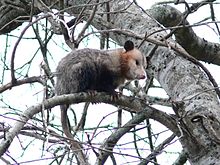Northern Opossum
| Northern Opossum | ||||||||||||
|---|---|---|---|---|---|---|---|---|---|---|---|---|

Northern opossum ( Didelphis virginiana ) in winter fur |
||||||||||||
| Systematics | ||||||||||||
|
||||||||||||
| Scientific name | ||||||||||||
| Didelphis virginiana | ||||||||||||
| Kerr , 1792 |
The North or Virginia Opossum ( Didelphis virginiana ) is a mammalian species in the genus of possums within the family of opossums (Didelphidae). It is the only common species of marsupial in the United States and southern Canada .
description
Northern opossums reach a body length of 32 to 50 cm (comparable to the house cat ), plus an equally long, bare tail. Their weight can be up to 5.5 kilograms. Their fur is whitish to gray in color, on the head they usually have three black stripes, one above each eye and one in the middle. All four feet have five clawed toes except for the first toe of the hind feet, which is developed like a thumb and can be placed opposite the other toes.
distribution and habitat
The original range of the northern opossums stretched from the east of the USA ( Pennsylvania ) to Costa Rica . In the course of the colonization of North America by the Europeans, they were able to expand their settlement area and are now also found in New England , southern Canada and on the US Pacific coast. Naturally, northern opossums live in wooded or bush-covered areas. However, they are cultural followers and can now also be found in plantations, parks and cities.
Way of life
Northern opossums are nocturnal solitary animals that conspecifics usually encounter aggressively. The northern opossums spend about 18 hours a day sleeping. With this considerable number of hours, they are among the most sleepy animals ever. They can swim well and, with the help of their prehensile tails, also climb well, sometimes hanging from branches with just their tails. Nevertheless, they mostly live on the ground. They spend the day in crevices, hollow trees, in structures they have dug themselves or in nests that they lay out with grass and leaves. Opossums are not permanently territorial, they only inhabit a certain area for a few months. During this time, however, they stubbornly defend it against other possums.
The natural enemies of the northern opossums include coyotes , foxes , owls and large birds of prey . If they are threatened, they pretend to be dead. This death is so conspicuous that it has become a popular phrase in America as "playing possum".
food
Northern opossums are omnivores . They feed on insects, small vertebrates, and carrion, as well as plant material such as fruits and grains.
Reproduction
Female opossums have a well-developed pouch with usually 13 teats in it, which are arranged in a circle. After a gestation period of only twelve to fourteen days (one of the shortest of all mammals) around 20 young animals are born. The newborns are tiny, only 1 cm long and weigh 0.13 g. Not all of them get into the bag, the rest die. The boys leave the bag for the first time at the age of two to three months. When there is not enough space for everyone in the bag, some young animals ride on the mother's back. At three to four months they are independent and towards the end of the first year of life the animals become sexually mature.
Their life expectancy in the wild is no more than two to three years, specimens in captivity get older (up to five years).
Human and northern opossum
As a cultural follower, northern opossums benefit more from the presence of humans than many other animals. They find food in rubbish bins and on plantations, and it is said that they sometimes tear poultry, which is why they are sometimes seen and hunted as a nuisance. Road traffic is another source of danger.
They were hunted for their meat, the opossum fur is used as fur , and they are also used as laboratory animals. In the 19th century, farmers in the United States even started breeding possums. The species is one of the common, non-threatened species.
literature
- Ronald M. Nowak: Walker's Mammals of the World. Johns Hopkins University Press, Baltimor 1999, ISBN 0-8018-5789-9 .
Web links
- Didelphis virginiana inthe IUCN 2013 Red List of Threatened Species . Posted by: Cuarón, AD, Emmons, L., Helgen, K., Reid, F., Lew, D., Patterson, B., Delgado, C. & Solari, S., 2008. Retrieved December 29, 2013 .
Individual evidence
- ↑ Michele Stable & Linda Gamlin: Literature on Animals. ISBN 9783625211020 , p. 7.

